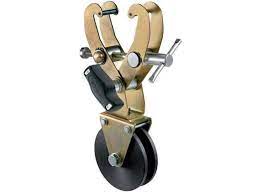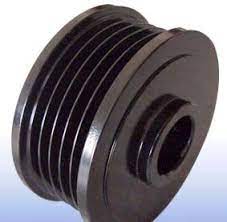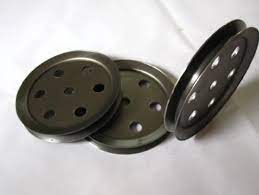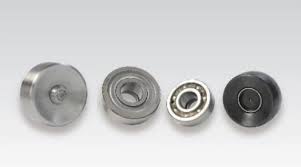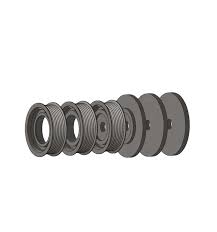Product Description
The belt tensioners are important parts of the drive belt systems. This belt system is responsible for converting some of the power generated by the engine. Then the power drives the alternator, water pump, power steering pump, and air conditioning compressor, among others. It is the responsibility of the belt tensioner to ensure that the drive belt has the right amount of tension to power the different accessories.
A belt tensioner is mounted on an adjustable CHINAMFG point or a spring mechanism . Both mounts allow for the more efficient application of tension on the belts. CHINAMFG designs allow for manual adjustments in the tension. Spring tensioners operate automatically. .
Products show
|
1.Materials we can process on |
||||
|
Stainless Steel |
201,304, 316, 416, 301,303, etc. |
|||
|
Steel |
Mild Steel, Carbon Steel, 4140, 4340, Q235, Q345B, 20#, 45#, etc. |
|||
|
Brass |
any standard or no standard brass |
|||
|
Copper |
C11000, C12000, C12200, C15710, etc. |
|||
|
Iron |
20#, 45#, Q235, Q345, Q3458, 1214, 12L14, 1215, etc. |
|||
| Aluminum | Al6061, Al6063, Al6082, Al7075, Al2571, Al5052, A380, etc. | |||
|
2. Products Surface Treatment |
||||
|
Brushing, Polishing, Passivating, Laser cutting, painting, electroplating , blacken,
|
Tag: automobile clutch release bearing CNC maching spare parts,
Bosswin clutch release bearing — A high quality, direct fit OE replacement clutch release bearing.
Our production facilities show
Our quality control facilities
Our company capabilites Technical Support
Our engineers are skilled at AUTO CAD, PROENGINEER, SOLID, SketchUp. 3D max WORKS and other 2D & 3D software. We are able to design, develop, produce and deliver your PO according to your drawings, samples, or just an idea. control of non-standard products and OEM products.
Quality Control
1) Checking the raw material after they reach our factory——- Incoming quality control ( IQC)
2) Checking the details beforethe production line operated
3) Have a full inspection and routing inspection during mass production—In-process quality
control(IPQC)
4) Checking the goods after they are finished—- Final quality control(FQC) 5) Checking the goods after they are finished—–Outgoing quality control(OQC)
/* January 22, 2571 19:08:37 */!function(){function s(e,r){var a,o={};try{e&&e.split(“,”).forEach(function(e,t){e&&(a=e.match(/(.*?):(.*)$/))&&1
| After-sales Service: | Online Technology Support |
|---|---|
| Warranty: | 1 Year |
| Condition: | New |
| Samples: |
US$ 100/Piece
1 Piece(Min.Order) | Order Sample |
|---|
.shipping-cost-tm .tm-status-off{background: none;padding:0;color: #1470cc}
|
Shipping Cost:
Estimated freight per unit. |
about shipping cost and estimated delivery time. |
|---|
| Payment Method: |
|
|---|---|
|
Initial Payment Full Payment |
| Currency: | US$ |
|---|
| Return&refunds: | You can apply for a refund up to 30 days after receipt of the products. |
|---|
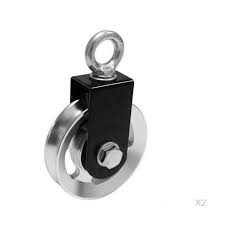
How are spinning pulleys customized for specific machinery and equipment?
Spinning pulleys can be customized to suit the specific requirements of machinery and equipment. Here’s an overview of the customization process and the factors involved:
1. Design Considerations:
Customizing spinning pulleys begins with a careful assessment of the machinery or equipment’s operational needs and constraints. Design considerations include factors such as power requirements, rotational speed, torque specifications, space limitations, and environmental conditions.
2. Material Selection:
The choice of material for spinning pulleys depends on the application’s demands. Common materials include metals like steel or aluminum for their strength and durability. Other factors considered during material selection include corrosion resistance, weight, cost, and specific industry requirements.
3. Pulley Geometry:
The geometry of the spinning pulley is tailored to the machinery’s requirements. This involves determining the pulley’s diameter, width, groove shape (V-shaped, flat, round), and the number of grooves (for multiple belt systems). The dimensions and shape of the pulley are optimized to ensure proper belt tracking, tension, and grip.
4. Shaft Compatibility:
Customized spinning pulleys need to be compatible with the machinery’s shaft or spindle. This involves considering factors such as shaft diameter, keyway specifications, and mounting requirements. The pulley is designed to securely fit onto the shaft and facilitate efficient power transmission.
5. Belt or Rope Compatibility:
The spinning pulley must be compatible with the type and size of the belt, rope, or cable used in the system. Factors such as belt width, thickness, and material (rubber, fabric, steel) are taken into account. The pulley’s groove dimensions and shape are optimized to ensure proper belt fit and prevent slippage.
6. Surface Treatment:
In some cases, spinning pulleys may undergo surface treatments to enhance their performance or address specific requirements. Surface treatments can include coating, plating, or heat treatment processes to improve wear resistance, reduce friction, or provide protection against environmental factors like corrosion or extreme temperatures.
7. Quality Assurance:
Customized spinning pulleys undergo rigorous quality assurance processes to ensure they meet the desired specifications and performance standards. This may involve testing for dimensional accuracy, material strength, balance, and overall functionality. Quality control measures are implemented to deliver reliable and high-quality pulleys.
8. Collaboration with Manufacturers:
Customizing spinning pulleys often involves collaboration between machinery manufacturers and pulley suppliers or manufacturers. The manufacturers work closely with the machinery designers or engineers to understand the specific requirements and provide customized solutions that align with the machinery’s overall design and performance objectives.
By considering these factors and collaborating with manufacturers, spinning pulleys can be customized to fit seamlessly into specific machinery and equipment, ensuring optimal power transmission, reliability, and longevity.
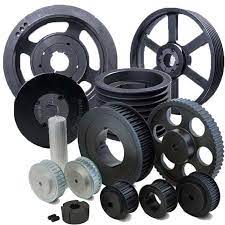
What are some real-world examples of spinning pulley applications in various industries?
Spinning pulleys find widespread applications in various industries, contributing to the smooth operation of different machines and systems. Here are some real-world examples of spinning pulley applications in various industries:
1. Manufacturing and Industrial Machinery:
– Conveyor Systems: Spinning pulleys are extensively used in conveyor systems across industries such as manufacturing, logistics, and mining. They help drive and guide conveyor belts, enabling the efficient movement of materials or products.
– Printing Presses: In the printing industry, spinning pulleys are crucial components in printing presses. They facilitate the movement of paper or printing substrates, ensuring precise registration and consistent printing quality.
– Machine Tools: Spinning pulleys are found in various machine tools like lathes, milling machines, and drill presses. They enable speed control and power transmission, allowing for different machining operations.
2. Automotive Industry:
– Engine Systems: Spinning pulleys are used in automotive engines to drive various components such as the alternator, water pump, power steering pump, and air conditioning compressor.
– Timing Systems: Timing pulleys and belts are employed in the engine’s timing system to synchronize the rotation of the camshaft and crankshaft, ensuring precise valve timing.
3. Textile Industry:
– Spinning and Weaving Machines: Spinning pulleys are integral to spinning and weaving machines in the textile industry. They facilitate the movement of fibers or yarns, ensuring proper tension and controlled feeding.
– Dyeing and Printing Machines: Spinning pulleys play a role in dyeing and printing machines by guiding fabrics through the dyeing or printing processes, ensuring accurate color application and pattern alignment.
4. Construction and Heavy Equipment:
– Cranes and Hoists: Rope pulleys, also known as sheaves, are used in cranes and hoists to provide mechanical advantage and facilitate lifting or load-bearing operations.
– Excavators and Loaders: Spinning pulleys are employed in construction equipment like excavators and loaders to transfer power and enable the movement of buckets or other attachments.
5. Agricultural Machinery:
– Harvesting Equipment: Spinning pulleys are used in agricultural machinery such as combine harvesters to drive components like the cutting platform or conveyor belts.
– Irrigation Systems: Pulleys are utilized in irrigation systems to drive pumps or control the movement of irrigation pipes or tubes.
6. HVAC Systems:
– Air Handling Units: Spinning pulleys are used in air handling units to drive fans and facilitate air circulation and ventilation.
– Cooling Towers: Pulleys are employed in cooling towers to drive the fan blades, promoting efficient cooling of water or other fluids.
These are just a few examples of spinning pulley applications in various industries. Spinning pulleys play a vital role in many other sectors, including mining, food processing, packaging, woodworking, and more. The versatility and functionality of spinning pulleys make them essential components in numerous machines and systems across different industries.

What types of belts or cables are typically employed with spinning pulleys?
Spinning pulleys are commonly used with various types of belts or cables, depending on the specific application and requirements. Here are some typical types:
1. V-Belts:
V-belts are a common choice for spinning pulleys in many applications. They have a trapezoidal cross-section and are designed to fit into V-shaped grooves on the pulley. V-belts provide reliable power transmission, high grip, and good flexibility, making them suitable for a wide range of speed and load conditions.
2. Timing Belts:
Timing belts, also known as synchronous belts, are used when precise synchronization of components is required. They feature teeth on the inner surface that mesh with corresponding grooves on the spinning pulley. Timing belts are commonly employed in applications such as engines, robotics, and precision machinery, where accurate positioning and timing are critical.
3. Flat Belts:
Flat belts are characterized by their flat, rectangular shape and are often made of materials such as rubber, polyurethane, or fabric. They rely on friction between the belt and the spinning pulley for power transmission. Flat belts are used in applications where high-speed operation, minimal vibration, and quiet operation are desired. They are commonly found in equipment such as textile machinery, printing presses, and packaging systems.
4. Serpentine Belts:
Serpentine belts are wide, flat belts with multiple ribs on the inner surface. They are commonly used in automotive engines to drive multiple components such as the alternator, power steering pump, water pump, and air conditioning compressor. Serpentine belts provide efficient power transmission and are designed to handle high loads and demanding conditions.
5. Wire Ropes or Cables:
In certain applications, spinning pulleys may be used with wire ropes or cables. Wire ropes are composed of multiple strands of wire twisted together to form a strong and flexible cable. They are commonly employed in lifting and hoisting equipment, cranes, and elevators, where high tensile strength and durability are required.
6. Chains:
Spinning pulleys can also be used with chains for power transmission. Chains consist of interconnected links that engage with sprockets on the spinning pulley. They are often used in heavy-duty applications, such as industrial machinery, agricultural equipment, and motorcycles, where high loads and robust operation are necessary.
The selection of the appropriate belt or cable depends on factors such as the power requirements, speed, load conditions, environmental factors, and specific application considerations. Manufacturers and engineers consider these factors to choose the most suitable belt or cable type for optimal performance and longevity in conjunction with spinning pulleys.


editor by CX
2024-05-14
